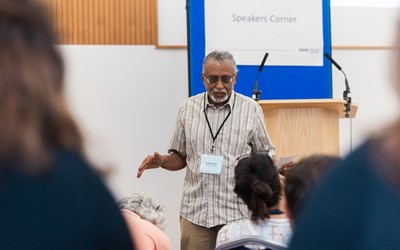William Lammons, Patient and Public Involvement Lead at NIHR ARC North Thames, outlines the nuts and bolts of patient and public involvement for health research, drawing on topics we covered at a recent training event.
“I have very little experience of PPIE, but I am aware of how important it is for medical research to happen with the people affected, rather than at them.”
We heard the above quote from an attendee of a recent training event we held. The topic was patient and public involvement and engagement (or PPIE) for research, and this comment put a finger on the training's purpose. Many people like the idea of PPIE in research, but are unclear on the nuts and bolts of doing it.
If you’re feeling the same way, we’ve summarised some insights below.


Pictured: William Lammons, Patient and Public Involvement Lead at NIHR ARC North Thames, presenting at the recent training day. The training was co-produced and co-delivered by public contributors from the NIHR ARC North Thames' Mental Health Research For All Advisory Group.
Recognise why PPIE matters
PPIE stands for patient and public involvement and engagement. It refers to research carried out 'with' or 'by' members of the public rather than ‘to’, ‘about’, or ‘for’ them.”
As well as the moral and ethical importance of involving individuals in research that concerns them, there are some clear ways PPIE can benefit research:
- Relevance: PPIE-informed research outcomes are more likely to chime with public concerns and needs.
- Quality: PPIE-informed research provides greater transparency and accountability to taxpayers and research funders about what is being researched and to what end.
- Impact: PPIE can help apply or “translate” research to the real world.
Understand the different levels of PPIE (and be realistic)
Not all PPIE is made equally, however. There is a spectrum of quality and quantity of public involvement.
PPIE can range from simply telling the public what your research has found, right through to research that is led directly by members of the public, and everything in between:



Different projects and topics will differ in their potential for public-led research. Yet it’s always important to ask: are we taking this as far as we could, and if not why not?
Know your options
If you’re working at an involvement or collaboration level of PPIE, there are various ways of engaging the public. Again, different formats will suit different projects, individuals and groups.
So, it’s important to consider all options carefully.

It is worth looking at this list and reflecting on which ones you would consider and which you would not. Perhaps some are more familiar, or you imagine could be more comfortable or less time-consuming. Think hard about each option and explore your assumptions. What are you ruling out that could be fruitful?
Spend as much time as possible on the ‘how’
Each of the above methods has their pros and cons.
However, what is more important than the format you use is how you approach these interactions with the public.
If, as a researcher, you think of PPIE simply as knowledge extraction you won’t get the best out of the process.
That is why we prefer to think of PPIE as ‘thinking with’ the public instead of ‘hearing from’ them.
Some guiding principles for helping create an atmosphere of ‘thinking with’ include:
- Clarity: Going into each engagement with a clear communication of your goal and what you wish to get out of the session helps with focus, motivation, and reduces the risk of working at cross purposes.
- Curiosity: Go to the session with an open mind and a genuine curiosity for what the public need from your research. This will likely enrich your exploration rather than distract from it.
- Openness: In your questioning, it’s important to use open-ended questions with a single focus. Similarly, treat all answers as valid, even if they surprise or disappoint you.
- Humanity: A great value of PPIE is that it helps humanise research. So, try to be less formal. Use lay terms for jargon. Define concepts that you can’t use synonyms for. Engage with the public collaborators beyond the specific questions you want to ask. Talk with them. Think of it like a chat.
- Flexibility: You’re doing PPIE to discover something new. So, while it’s important to go in with a focus and goal, be prepared to be flexible and as collaborative as possible. You might discover something that requires the session to run a little differently and that’s OK.
Commit to staying the course
Because PPIE is collaborative, not extractive, it’s vital not to disappear when you’ve got the information you needed from your collaborators.
In our experience, PPIE collaborators consistently request updates on projects after an activity. Many will want to know what you made of their insights.
It doesn’t have to be regular updates. Every 3-6 months is fine to share, especially for a bigger project. And remember that “But nothing has happened” is still worth communicating. At least they know, rather that having to guess.
“You said, we did” type formats can be really helpful to illustrate exactly how contributions have shaped research.
Fundamentally, checking in with folks helps them feel like their role had an impact, like they’re a part of your project. You can even ask them how they found the experience so you can approve your approach for next time.
We hope you found these pointers helpful. If you'd like to learn more, sign up to our mailing list to hear about future PPIE training events, or attend a UCL BRC PPIE training day.

 15 Jul 2024
15 Jul 2024

